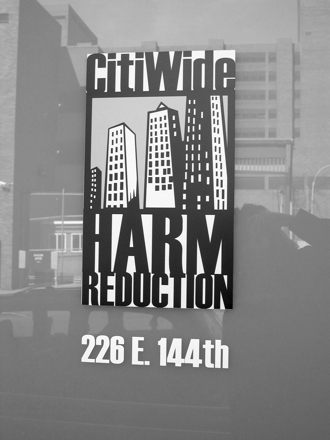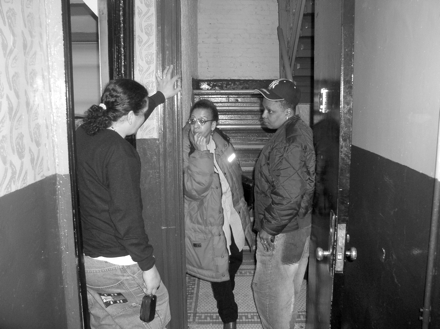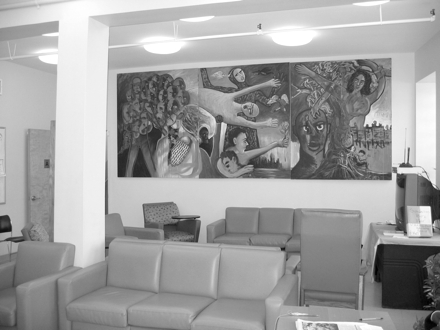Abstract
Marginalized populations are disproportionately affected by HIV, yet they have poor access to health services. Outreach programs focus on improving access, but few are evaluated. We assessed a medical outreach program targeting unstably housed, HIV-infected individuals. We extracted data from 2003–2005 to examine whether keeping medical appointments was associated with patient and program characteristics.
Patients kept appointments more frequently when they were walk-in or same-day appointments (compared with future appointments; adjusted odds ratio [AOR]=1.69; 95% confidence interval [CI] = 1.38, 2.08), when they were at a community-based organization’s drop-in center (compared with single-room occupancy hotels; AOR=2.50; 95% CI=1.54, 4.17), or when made by nonmedical providers (compared with medical providers; future appointments: AOR = 1.38; 95% CI = 1.05, 1.80; same-day appointments: AOR = 1.70; 95% CI = 1.03, 2.81).
These findings demonstrate the importance of program-related characteristics in health services delivery to marginalized populations.
MARGINALIZED POPULATIONS, such as racial/ethnic minorities, substance users, and the unstably housed, are disproportionately affected by HIV disease, yet they have poor access to HIV primary care services.1–8 Many outreach programs focus on improving access to care, but few have been evaluated. Improving access to HIV ambulatory care services is important for public health reasons and is specifically associated with fewer hospitalizations.9 We evaluated a medical outreach program targeting HIV-infected individuals living in single-room occupancy hotels. Specifically, we examined patient- and program-related factors associated with keeping medical appointments.
PROGRAM DESCRIPTION
Since 1999, physicians from Montefiore Medical Center, a university teaching hospital in the Bronx, New York, have collaborated with the outreach team from CitiWide Harm Reduction, a community-based organization in the Bronx that provides harm reduction services to HIV-infected and high-risk individuals.10,11 With the outreach team, physicians deliver medical outreach, including medical triage, evaluation, and education, to single-room occupancy hotel residents. Additional outreach services include harm reduction education and supplies (e.g., condoms, bleach kits to clean syringes), syringe exchange, toilet paper, personal care and first aid kits, and occasionally food. Physicians or other outreach team members also refer residents for services, including medical care to the Health Services Program.
Staffed by Montefiore medical providers (physicians, a nurse practitioner, and a physician assistant) and CitiWide nonmedical and supportive service providers (i.e., administrator, administrative assistant, and program assistants and outreach workers), the Health Services Program offers medical services ranging from acute care to comprehensive HIV care. The Health Services Program delivers care in 1 of 3 settings: patients’ single-room occupancy hotel rooms, CitiWide’s drop-in center, or Montefiore’s community clinic. Services provided at the hotel rooms and drop-in center are similar; patient history is obtained and physical examinations, prescriptions, vaccinations, and referrals are provided. Services provided at the clinic are more extensive and also include blood tests and x-rays. Patients interested in utilizing health services can make appointments during outreach or while at CitiWide’s drop-in center. Appointments are available with any health care provider in all locations. Same-day and walk-in appointments are available at CitiWide’s drop-in center, and future appointments are available at all locations.
EVALUATION
Methods
We examined a total of 2666 medical appointment records with unique patient identifiers from CitiWide’s and Montefiore’s databases from 2003 to 2005. Data elements included patients’ sociodemographic information, appointment date, appointment location (i.e., single-room occupancy hotel, CitiWide’s drop-in center, or Montefiore’s community clinic), medical provider to be seen, date the appointment was made, person making the appointment (i.e., medical provider or nonmedical provider), and whether the appointment was kept. Appointments made on the same day in which appointments occurred were defined as same-day or walk-in appointments. We used bivariate analyses (using the χ2 test) and logistic regression analyses using general estimating equations to evaluate the association between kept appointments and patient- and program-related variables.
Records with any missing data elements were dropped (394 or 14.8%). Results were similar when records with partial information were retained.
Patient and Program Characteristics and Kept Appointments
Among the 416 patients who made appointments, the mean age was 42.7 years; the majority were male (60.3%), Black (57.7%) or Hispanic (36.3%), and had annual incomes under $12 000 (96.2%). There were no differences in patients’ characteristics between those who kept versus those who missed appointments.
For all appointments, patients kept more same-day and walk-in appointments than they did future appointments (adjusted odds ratio [AOR] = 1.69; 95% confidence interval [CI] = 1.38, 2.08; Table 1 ▶). Patients were most likely to keep appointments at the community-based organization’s drop-in center (compared with at their single-room occupancy hotel room: AOR = 2.50; 95% CI = 1.54, 4.17; compared with at a community clinic: AOR = 1.30; 95% CI = 0.91, 1.85), and when made by non-medical versus medical providers (future appointments: AOR=1.38; 95% CI=1.05, 1.80; same-day appointments: AOR=1.70, 95% CI=1.03, 2.81).
TABLE 1—
Program Characteristics Associated With Appointments Kept With a Medical Outreach Program: Bronx, New York, 2003–2005
| Kept Appointments | ||||
| Total | No. (%) | OR (95% CI) | AOR (95% CI) | |
| All appointments | 2272 | 666 (29.3) | ||
| Type of appointment | ||||
| Same-day or walk-in | 737 | 309 (41.9) | 2.29 (1.85, 2.82) | 1.69 (1.38, 2.08) |
| Future | 1535 | 357 (23.3) | 1.0 | 1.0 |
| Future appointments | ||||
| Location of appointment | ||||
| SRO hotel room | 302 | 32 (10.6) | 0.35 (0.22, 0.56) | 0.40 (0.24, 0.65) |
| Community clinic | 362 | 80 (22.1) | 0.71 (0.50, 1.00) | 0.77 (0.54, 1.10) |
| CBO’s drop-in center | 871 | 245 (28.1) | 1.0 | 1.0 |
| Person making appointment | ||||
| Nonmedical provider | 746 | 214 (28.7) | 1.63 (1.25, 2.14) | 1.38 (1.05, 1.80) |
| Medical provider | 789 | 143 (18.1) | 1.0 | 1.0 |
| Same-day or walk-in appointments | ||||
| Location of appointment | ||||
| CBO’s drop-in center | 737 | 309 (41.9) | . . . | . . . |
| Person making appointment | ||||
| Nonmedical provider | 668 | 288 (43.1) | 1.70 (1.04, 2.79) | 1.70 (1.03, 2.81) |
| Medical provider | 69 | 21 (30.4) | 1.0 | 1.0 |
Note. OR = odds ratio; CI = confidence interval; AOR = adjusted odds ratio; SRO = single-room occupancy; CBO = community-based organization.
DISCUSSION AND NEXT STEPS
In the Health Services Program, a comprehensive collaborative program providing HIV medical services to a marginalized population, patients kept 29.3% of all appointments. Patients kept appointments more frequently when they were same-day or walk-in appointments compared with future appointments, when they were at CitiWide’s drop-in center (compared with those at other locations), or when they were made by nonmedical providers (compared with those made by medical providers). There were no differences in kept appointments by patients’ sociodemographic characteristics, although we collected limited patient-related data.
In traditional medical settings, same-day appointments improve access to health care.12,13 This study shows that same-day appointments are important for improving access to care for HIV-infected marginalized individuals as well.
Patients were most likely to keep appointments made at CitiWide’s drop-in center, a place where patients experience “one-stop shopping” by addressing medical and broader structural, social, and psychological needs, than they were at other locations. CitiWide’s drop-in center provides a full range of services that address needs unique to the target population. Although the clinic has additional on-site resources (e.g., HIV nutritionist, psychiatrist), these resources may not address the population’s broader needs. However, the difference in kept appointments between the drop-in center and the clinic was not statistically significant.
We were surprised by how few appointments were kept when made by medical providers and when made at the single-room occupancy hotels, particularly because previous research demonstrated medical home visits increased ambulatory visits among disadvantaged individuals.14 Some patients may feel obligated to make appointments if made by medical providers, when they are not truly interested. Furthermore, single-room occupancy hotel residents may want to leave a negative environment, or may not perceive appointments in their rooms as true medical appointments, and therefore do not prioritize them. Based on our findings, we modified the Health Services Program by offering more same-day appointments at CitiWide’s drop-in center and fewer at the single-room occupancy hotels. Additionally, we are reconsidering the utility of medical providers on outreach.
Most studies examining HIV health services utilization focus on patient-related factors. We examined and identified program-related factors that were important in accessing medical services. Although patient-related factors are known to influence health services utilization, the medical community must also focus on system-related factors, such as how health care is delivered, particularly for marginalized populations. Close evaluation of health care delivery is crucial for appropriate resource allocation.
Our study’s findings that patients kept appointments more frequently when they were walk-in or same-day appointments (compared with future appointments), when they were at a community-based organization’s drop-in center (compared with other locations), or when made by nonmedical providers (compared with medical providers), can help guide health care service delivery to marginalized populations.
Figure 1.

Outreach doctor in a single-room occupancy hotel.
Figure 2.

CitiWide’s logo.
Figure 3.

Outreach team in a single-room occupancy hotel.
Figure 4.

CitiWide’s drop-in center.
Figure 5.

A single-room occupancy hotel.
Acknowledgments
This study was supported by the Centers for Disease Control and Prevention (CDC; grant U65/CCU223363-01), the Health Resources and Services Administration (grant H97 HA 00247-01), and the Center for AIDS Research (NIH grant AI-51519). C. O. Cunningham is a Robert Wood Johnson Foundation Harold Amos Medical Faculty Development Program Scholar.
We acknowledge Lisa Fitzpatrick, MD, MPH, of the CDC, for her contribution to this study, and we thank Belinda Taveras and David Matthews for their work in ensuring high-quality data at CitiWide Harm Reduction.
Human Participant Protection Institutional review boards at Montefiore Medical Center and the Centers for Disease Control and Prevention approved this study.
Peer Reviewed
Contributors C.O. Cunningham cofounded the program, conceptualized the study, analyzed the data, and led the writing of the article. J. P. Sanchez led all aspects of data analysis. D. I. Heller cofounded the program and oversaw data collection. N. L. Sohler made a significant contribution to all aspects of the research, including study design, and analysis and contributed to the writing of the article. All authors helped to interpret findings and reviewed drafts of the article.
References
- 1.Centers for Disease Control and Prevention. HIV/AIDS Surveillance Report, 2004. Vol 16. Atlanta, Ga: Centers for Disease Control and Prevention; 2005:1–46.
- 2.Shapiro MF, Morton SC, McCaffrey DF, et al. Variations in the care of HIV-infected adults in the United States: results from the HIV Cost and Services Utilization Study. JAMA. 1999;281: 2305–2315. [DOI] [PubMed] [Google Scholar]
- 3.Robertson MJ, Clark RA, Charlebois ED, et al. HIV seroprevalence among homeless and marginally housed adults in San Francisco. Am J Public Health. 2004;94:1207–1217. [DOI] [PMC free article] [PubMed] [Google Scholar]
- 4.The HIV Research Network. Hospital and outpatient health services utilization among HIV-infected patients in care in 1999. J Acquir Immune Defic Syndr. 2002;30:21–26. [DOI] [PubMed] [Google Scholar]
- 5.Arno PS, Bonuck KA, Green J, et al. The impact of housing status on health care utilization among persons with HIV disease. J Health Care Poor Underserved. 1996;7:36–49. [DOI] [PubMed] [Google Scholar]
- 6.Fleishman JA, Gebo KA, Reilly ED, et al. Hospital and outpatient health services utilization among HIV-infected adults in care 2000–2002. Med Care. 2005;43(suppl 9):40–52. [DOI] [PubMed] [Google Scholar]
- 7.Smith MY, Rapkin BD, Winkel G, Springer C, Chhabra R, Feldman IS. Housing status and health care service utilization among low-income persons with HIV/AIDS. J Gen Intern Med. 2000;15:731–738. [DOI] [PMC free article] [PubMed] [Google Scholar]
- 8.Welch KJ, Morse A. Survival patterns among HIV+ individuals based on health care utilization. J Natl Med Assoc. 2001;93:214–219. [PMC free article] [PubMed] [Google Scholar]
- 9.Cunningham WE, Mosen DM, Hays RD, Andersen RM, Shapiro MF. Access to community-based medical services and number of hospitalizations among patients with HIV disease: are they related? J Acquir Immune Defic Syndr Hum Retrovirol. 1996;13: 327–335. [DOI] [PubMed] [Google Scholar]
- 10.Cunningham CO, Shapiro S, Berg KM, Sacajiu G, Paccione G, Goulet JL. An evaluation of a medical outreach program targeting unstably housed HIV-infected individuals. J Health Care Poor Underserved. 2005;16:127–138. [DOI] [PubMed] [Google Scholar]
- 11.Heller D, McCoy K, Cunningham C. An invisible barrier to integrating HIV primary care with harm reduction services: philosophical clashes between the harm reduction and medical models. Public Health Rep. 2004;119:32–39. [DOI] [PMC free article] [PubMed] [Google Scholar]
- 12.Mallard SD, Leakeas T, Duncan WJ, Fleenor ME, Sinsky RJ. Same-day scheduling in a public health clinic: a pilot study. J Public Health Manag Pract. 2004;10:148–155. [DOI] [PubMed] [Google Scholar]
- 13.Murray M, Bodenheimer T, Rittenhouse D, Grumbach K. Improving timely access to primary care: case studies of the advanced access model. JAMA. 2003;289:1042–1046. [DOI] [PubMed] [Google Scholar]
- 14.Margolis PA, Lannon CM, Stevens R, et al. Linking clinical and public health approaches to improve access to health care for socially disadvantaged mothers and children: a feasibility study. Arch Pediatr Adolesc Med. 1996; 150:815–821. [DOI] [PubMed] [Google Scholar]


